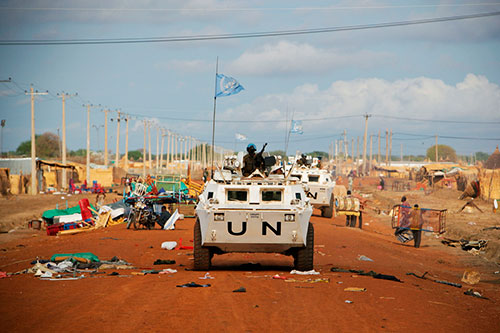3.1 What is humanitarian intervention?
The term humanitarian intervention is defined by Holzgrefe as:
The threat or use of force across state borders by a state (or a group of states) aimed at preventing or ending widespread and grave violations of the fundamental human rights of individuals other than its own citizens, without the permission of the state within whose territory force is applied.
This definition alone indicates some of the key problematic issues surrounding humanitarian intervention. Firstly, it involves the use of force (or a threat thereof) against another state without its consent. This action itself indicates an attack on state sovereignty, which is additionally strengthened by the second element of this definition: implication of a failure of the state in question to secure the human rights of its citizens.
Furthermore, there are several misconceptions about the meaning of humanitarian intervention, some of which can be clarified as follows:
- Humanitarian intervention does not have the same meaning as humanitarian assistance. There is a clear distinction between those two categories, based on the question of consent. In situations where humanitarian assistance is needed, the host state must consent to it. During IAC, the parties to an armed conflict are in principle obliged under the rules of IHL to permit relief operations for the benefit of civilians, without distinction based on whether they belong to an enemy state or not. The consent of the state should not be a relevant issue. However, in cases where no armed conflict is taking place, the consent of the host state becomes crucial. International law is clear in posing no objections to the provision of humanitarian assistance. As confirmed by the ICJ in the Nicaragua Case:
There can be no doubt that the provision of strictly humanitarian aid to persons or forces in another country, whatever their political affiliations or objectives, cannot be regarded as unlawful intervention, or as in any other way contrary to international law
- The use of force by a state in order to rescue its own nationals abroad does not amount to humanitarian intervention. The famous case illustrating such an act was the rescue by Israel of hostages held captive at Entebbe airport in Uganda, after the hijacking of an Air France aeroplane. Protection of citizens abroad was also used as a justification for the invasion of Grenada by the US in 1984.
- An intervention based on the invitation by another state does not constitute humanitarian intervention.
- Peacekeeping operations (PKO) are not humanitarian interventions. PKO are deployed by the UN on the basis of mandates from the UN Security Council. Their main aim is to maintain international peace and security usually in the aftermath of armed conflict, but some operations are deployed in order to prevent the outbreak of conflict.
Examples of past humanitarian interventions
Iraq (1991) – provision of humanitarian assistance to ethnic Kurds by the US-led coalition troops and maintenance of a no-fly zone to prevent attack by Iraqi air forces.
Somalia (1992) – The USA and the UN intervened to ensure the delivery of international humanitarian aid to the region.
Kosovo (1999) – The NATO bombing of Belgrade as a response to widespread attacks on the civilian population.
Sierra Leone (2000) – UK troops deployed to support UN peacekeeping forces to protect civilians from gross violations of their rights committed by rebel forces.
Darfur, Sudan (2004) – The African Union deployed peacekeeping troops to protect civilians in the region, especially those in refugee camps. However, the intervention failed to limit or eliminate the violence.

